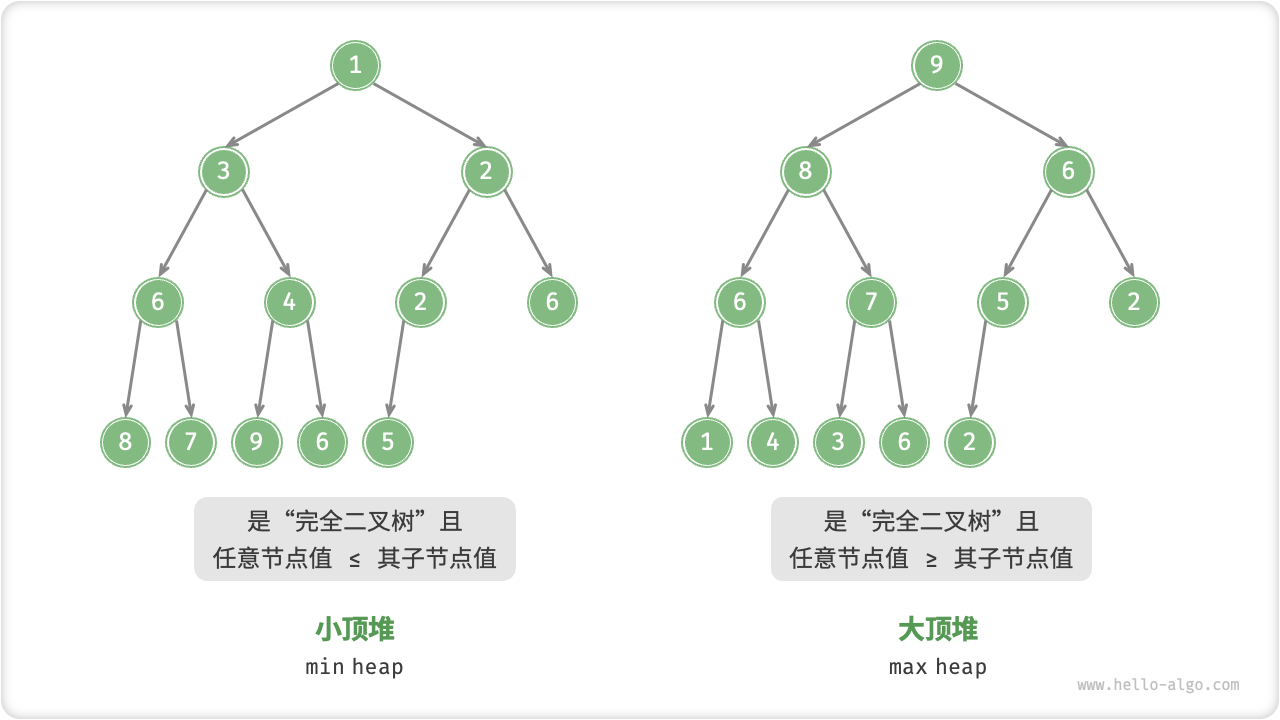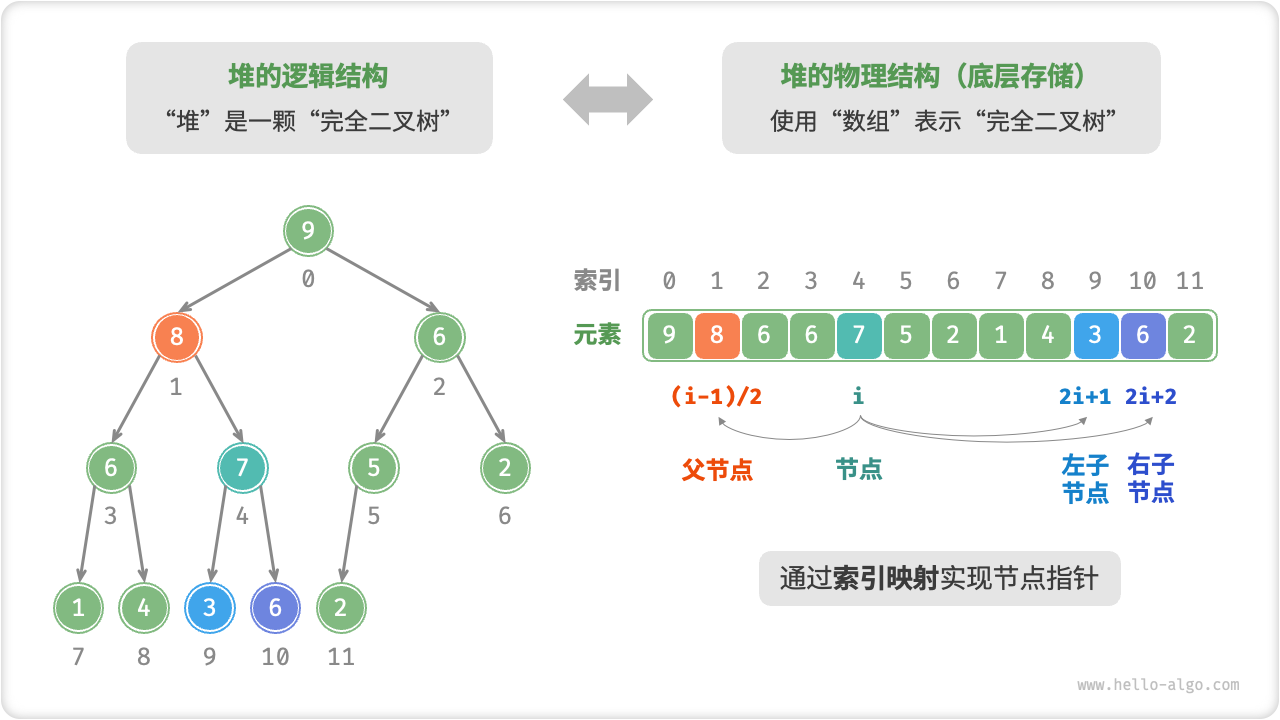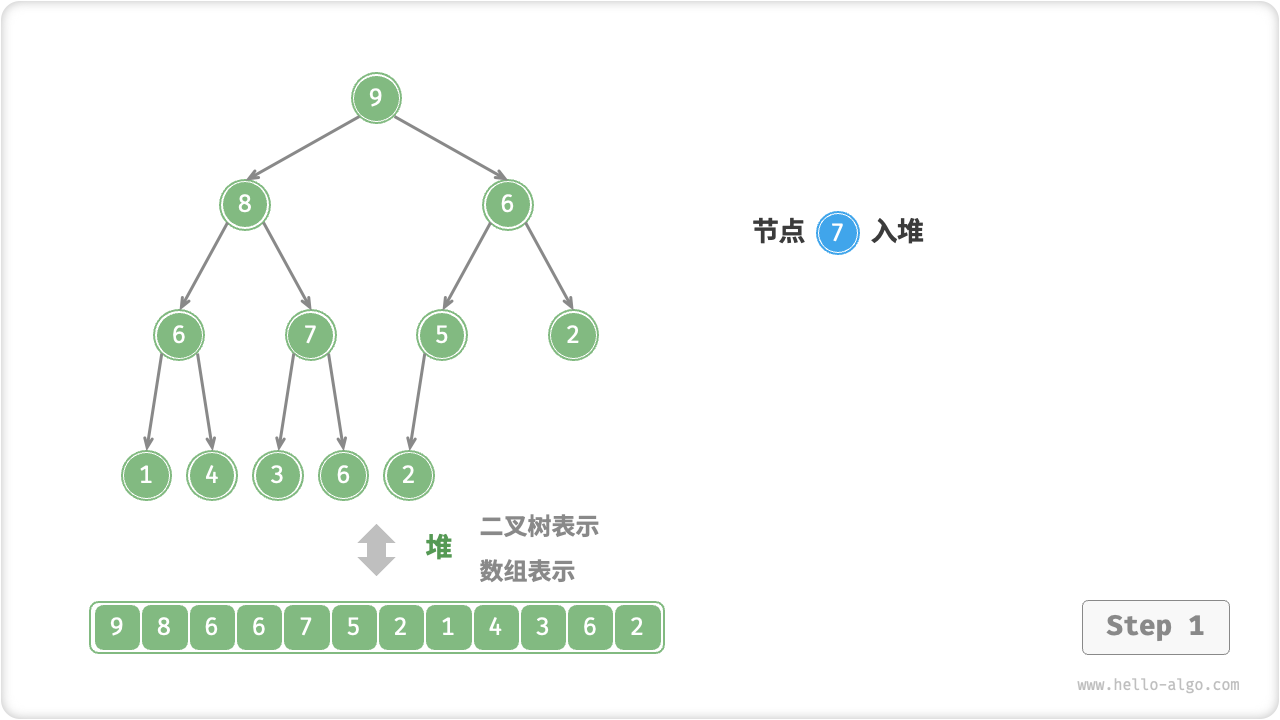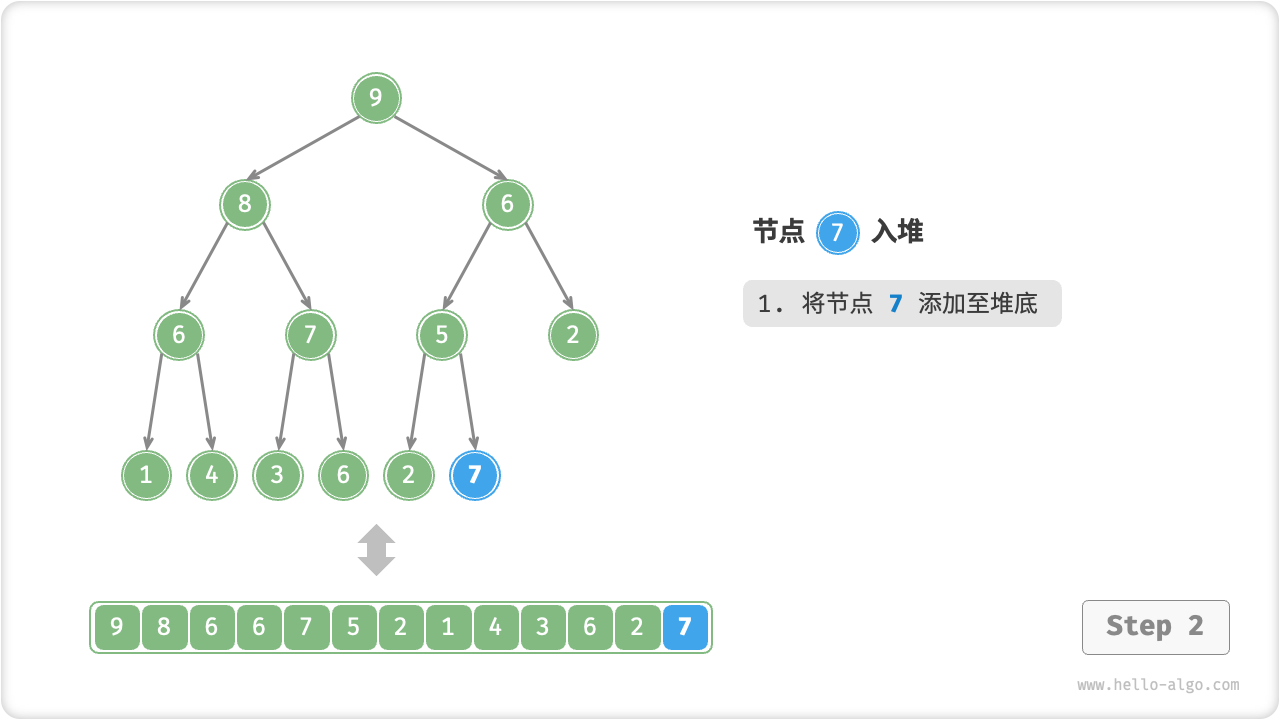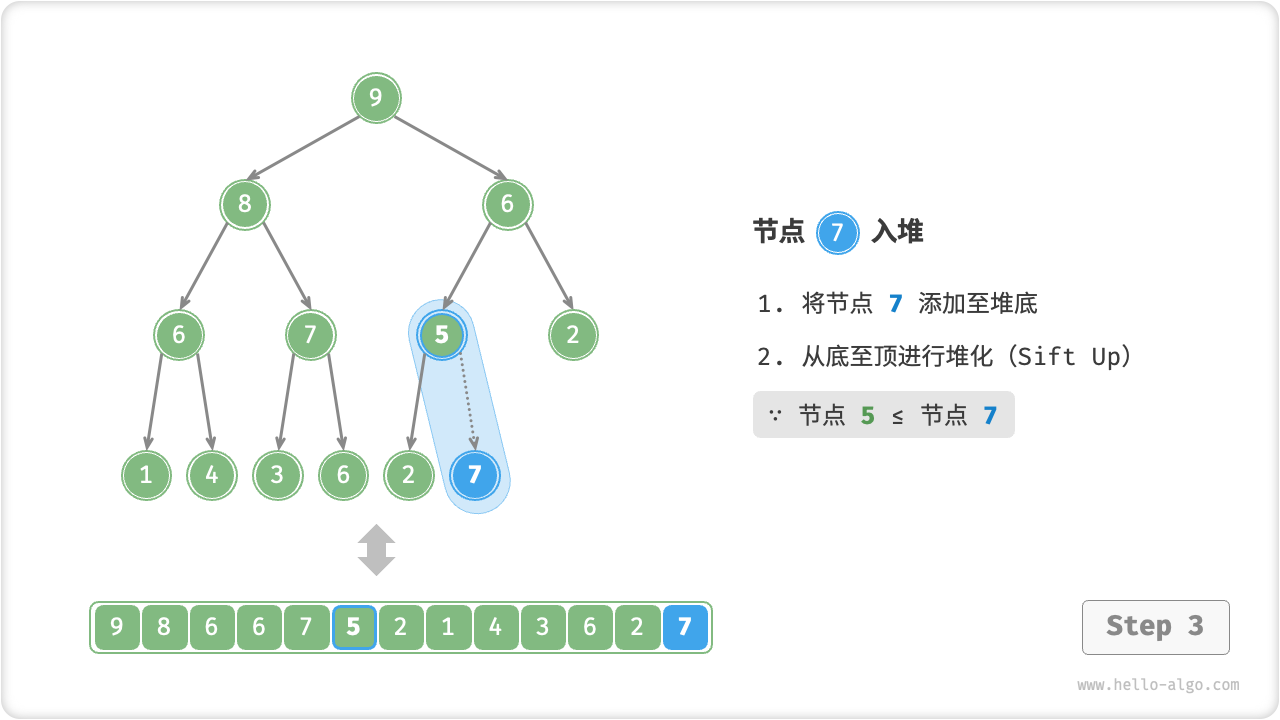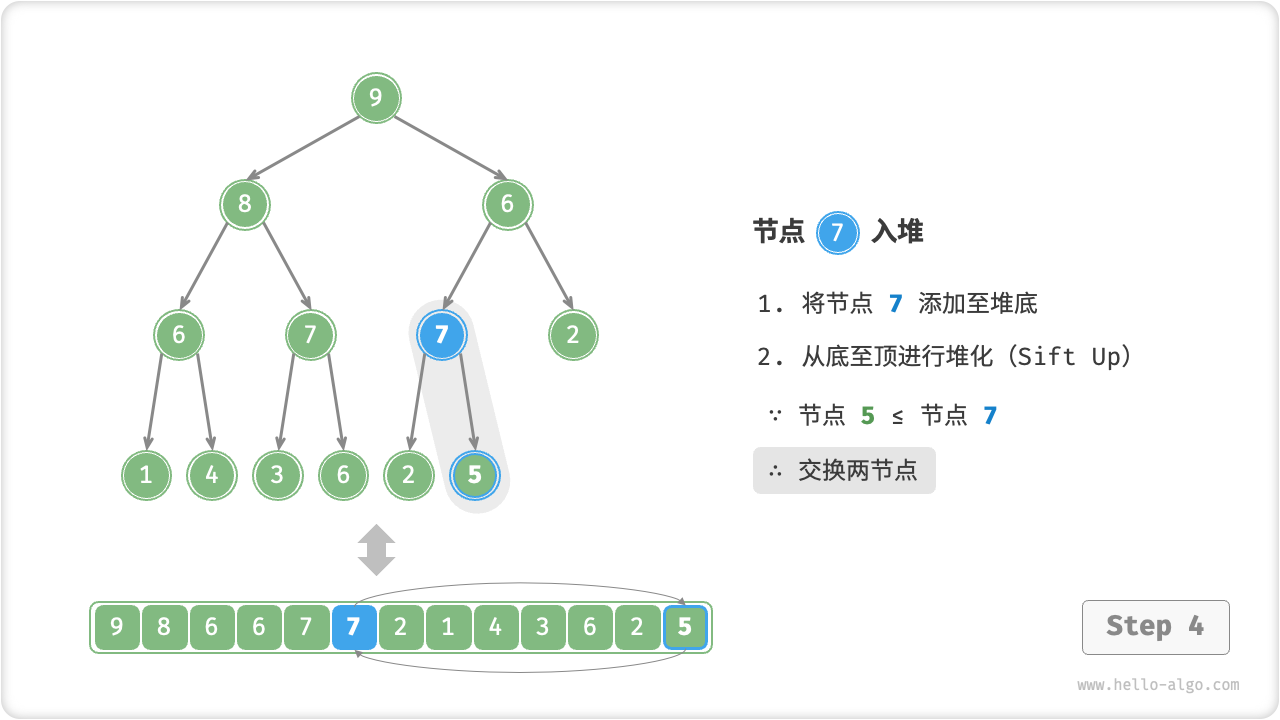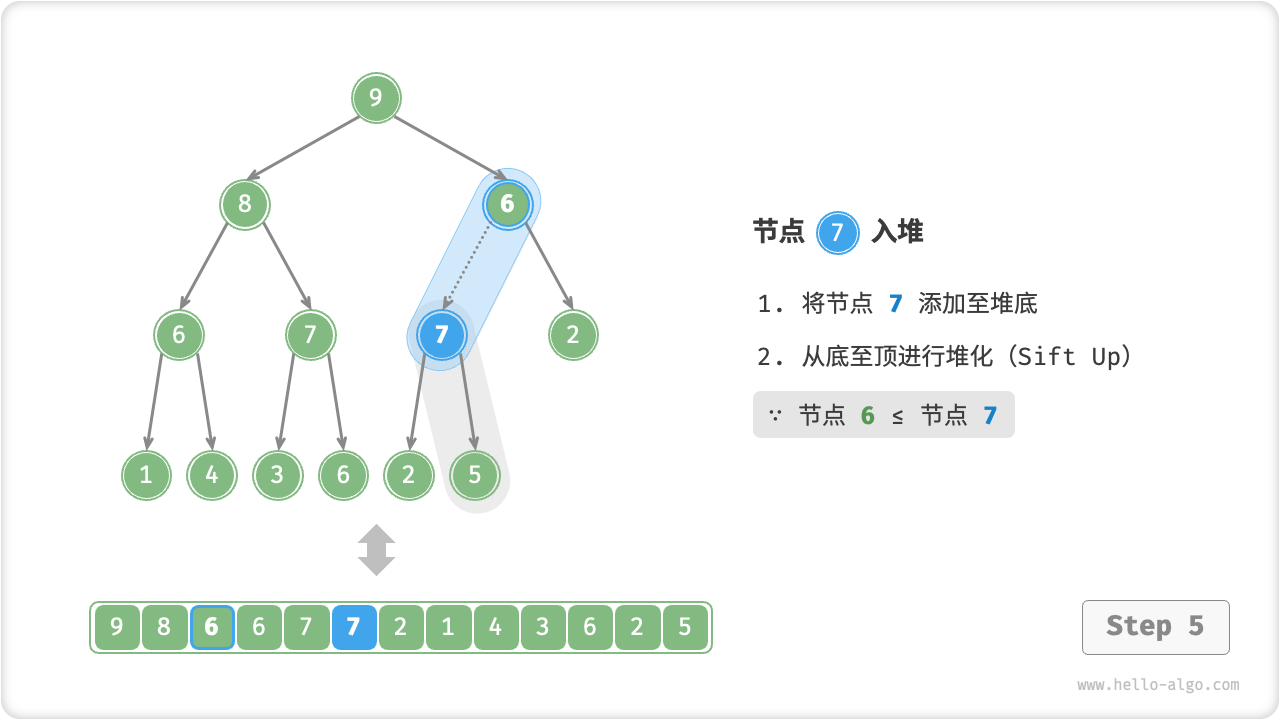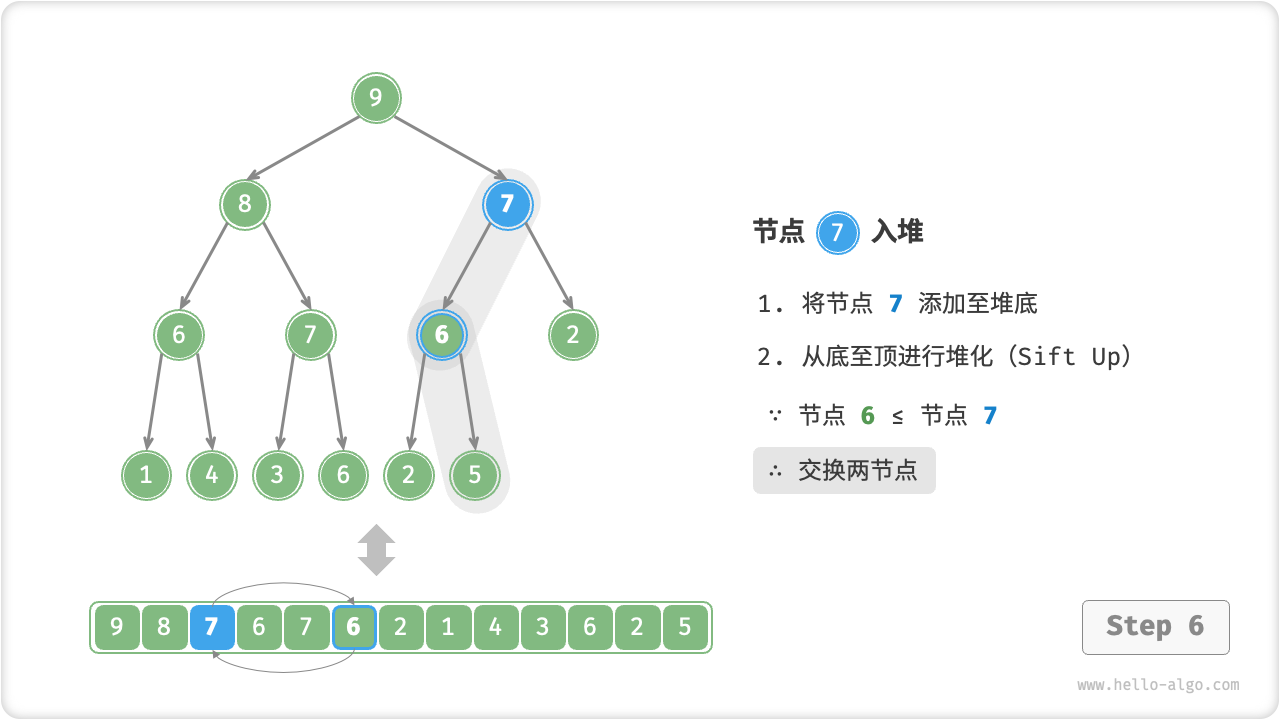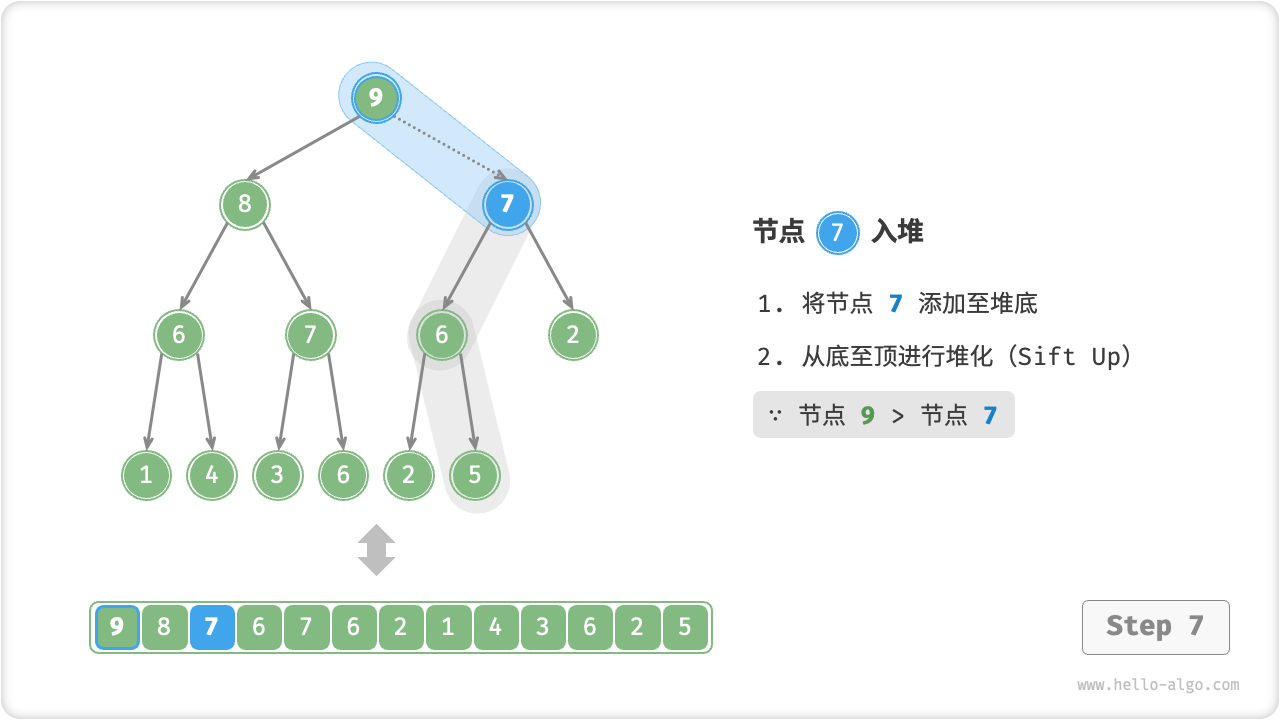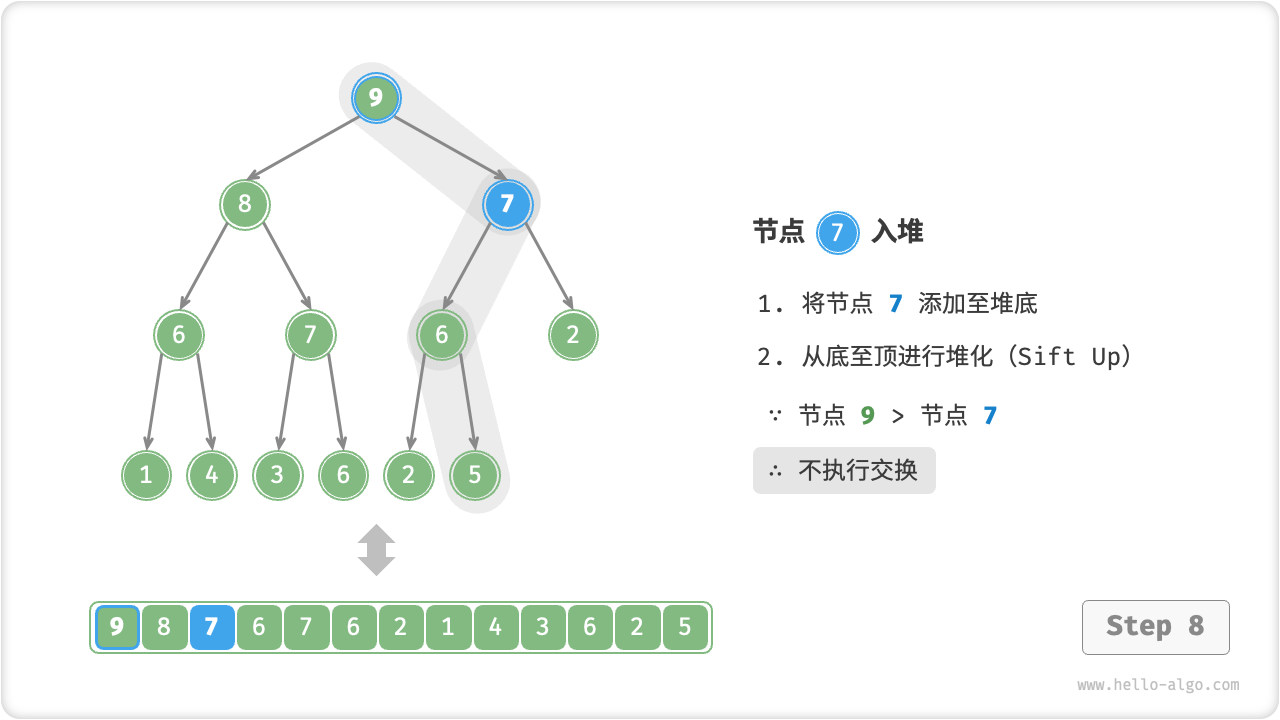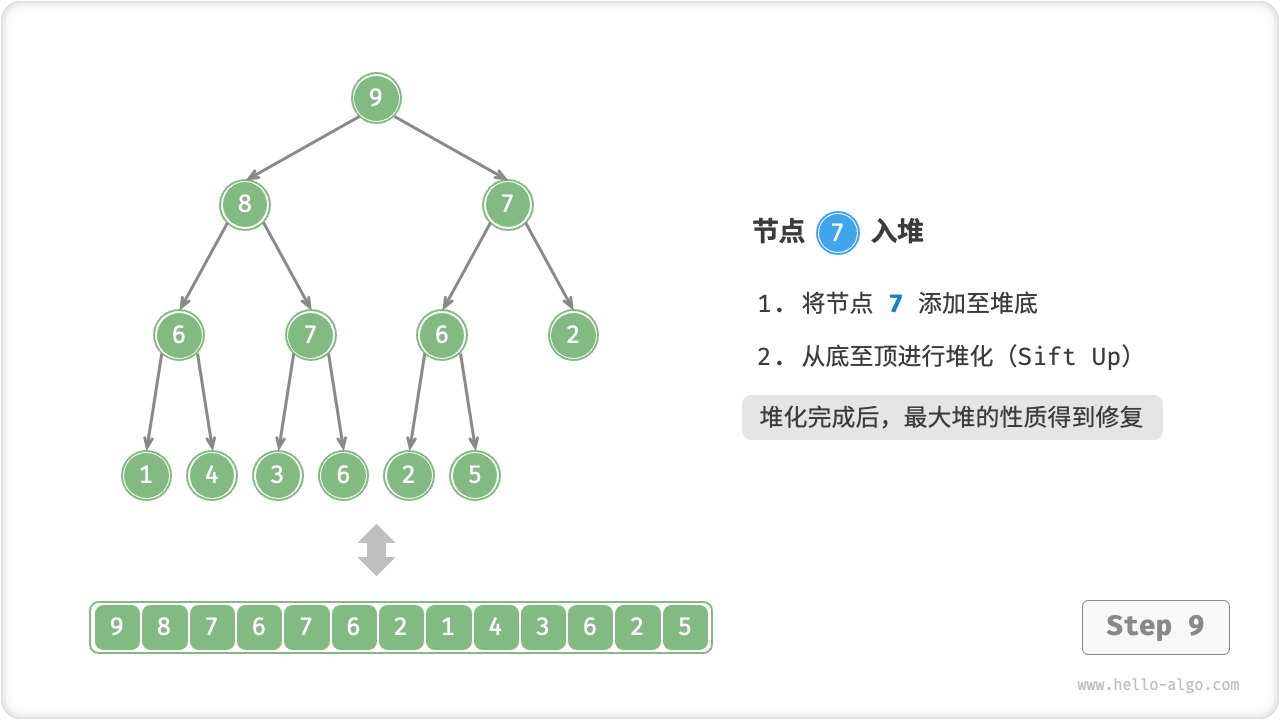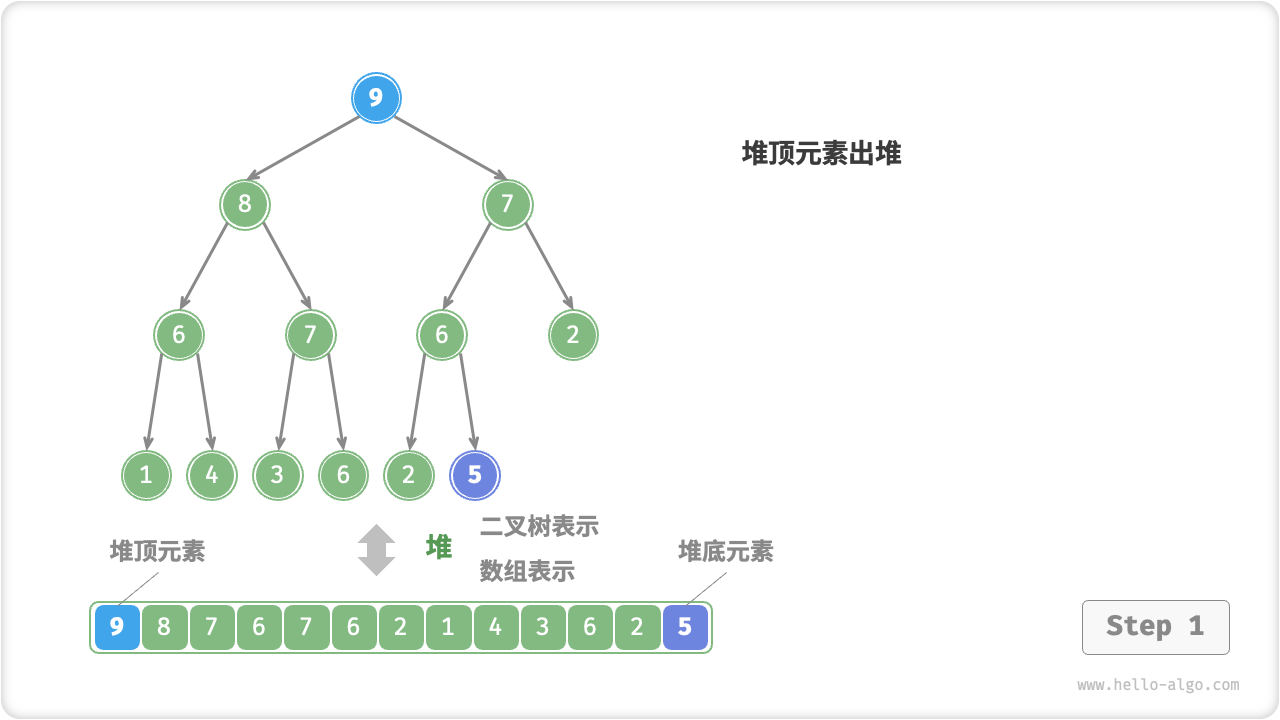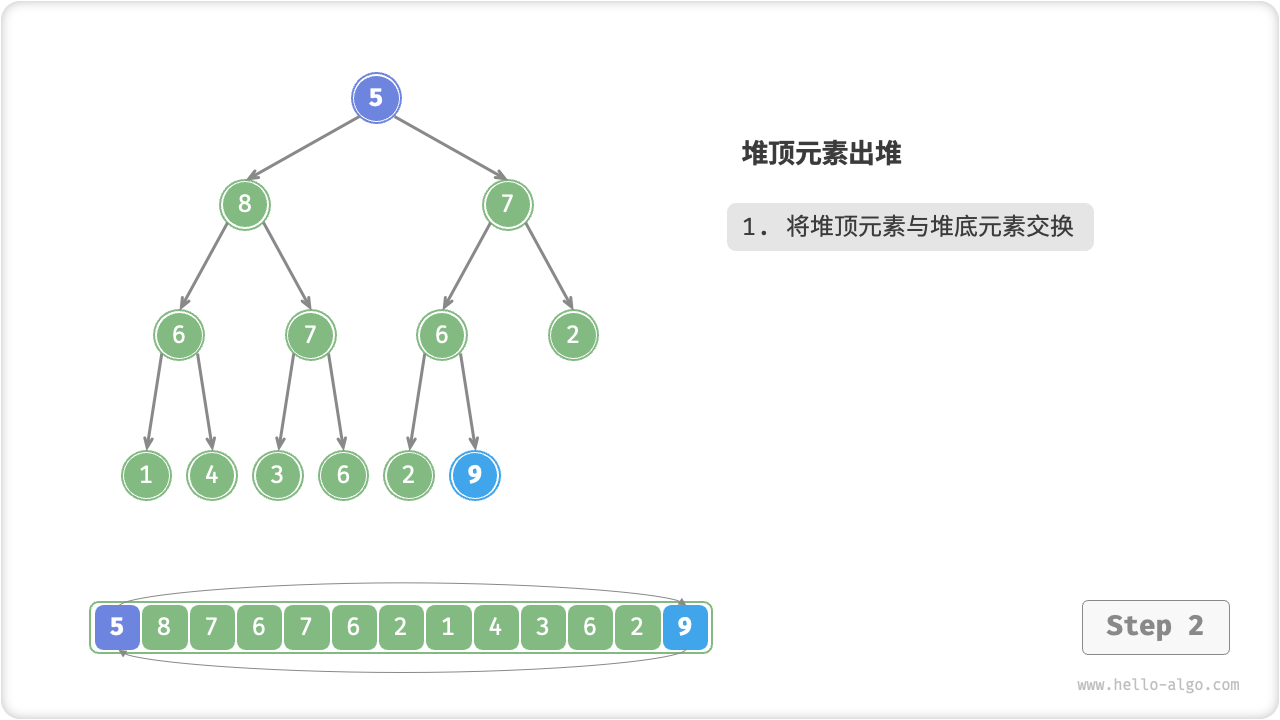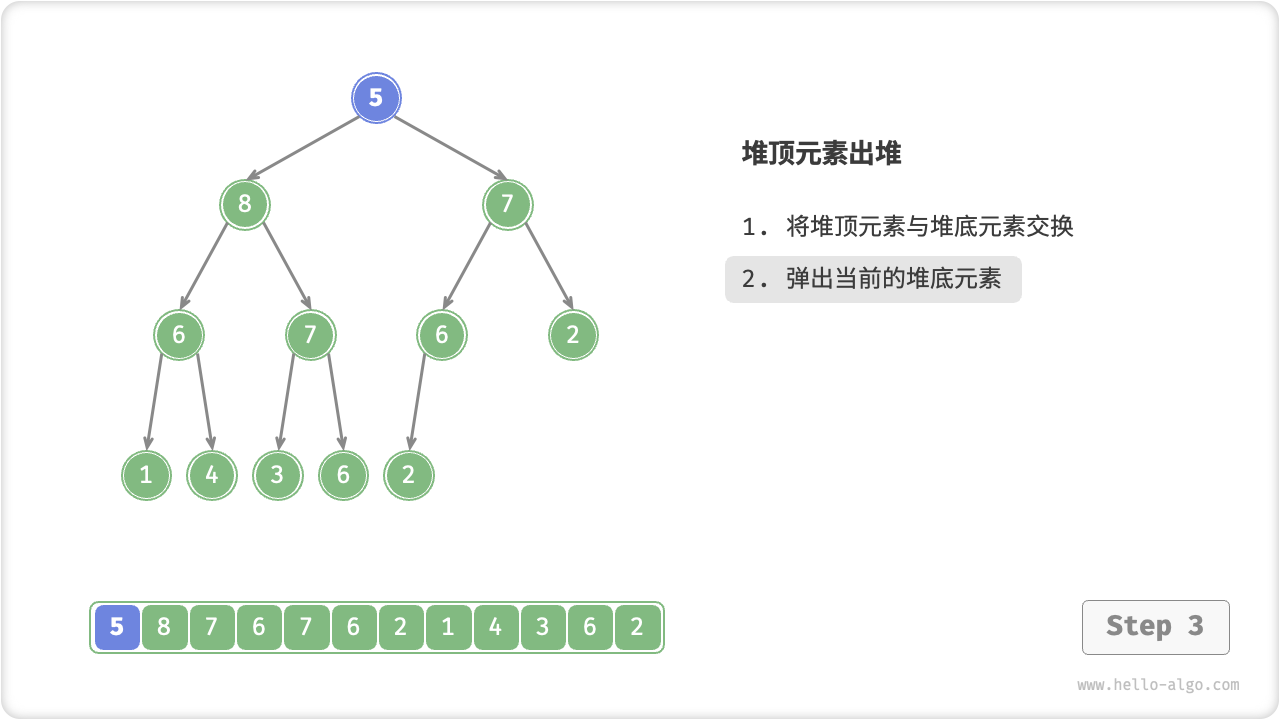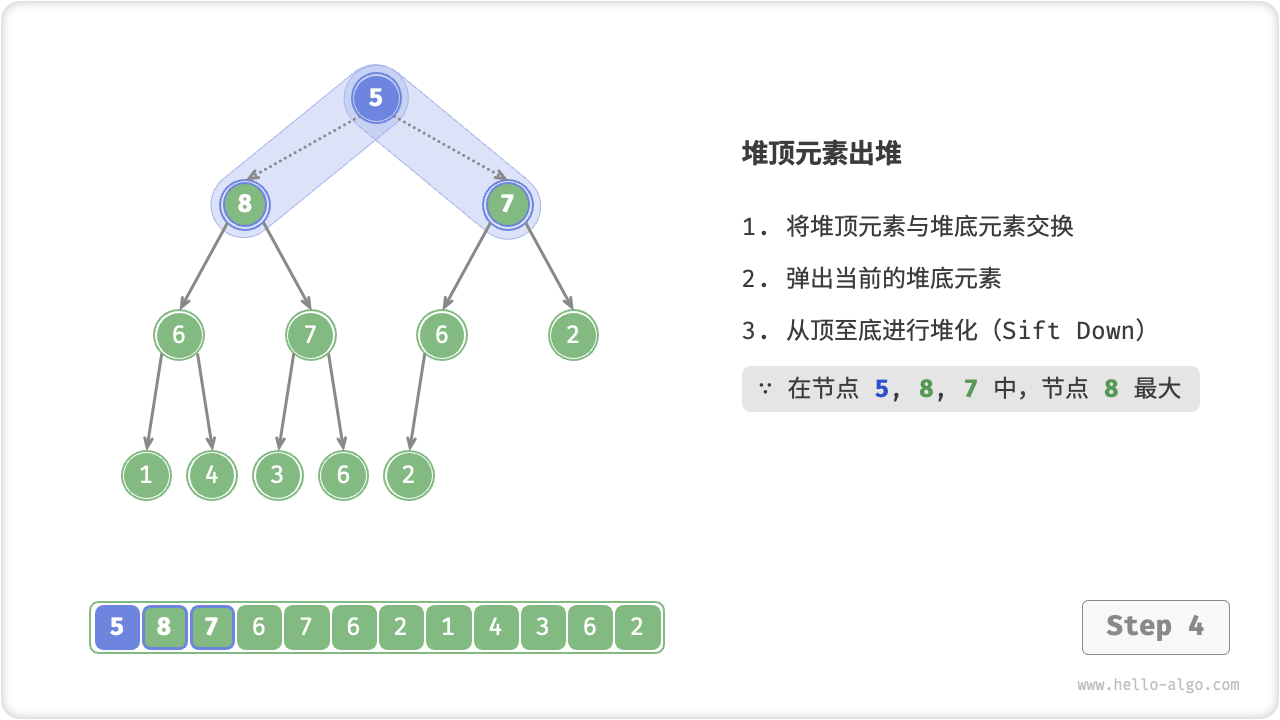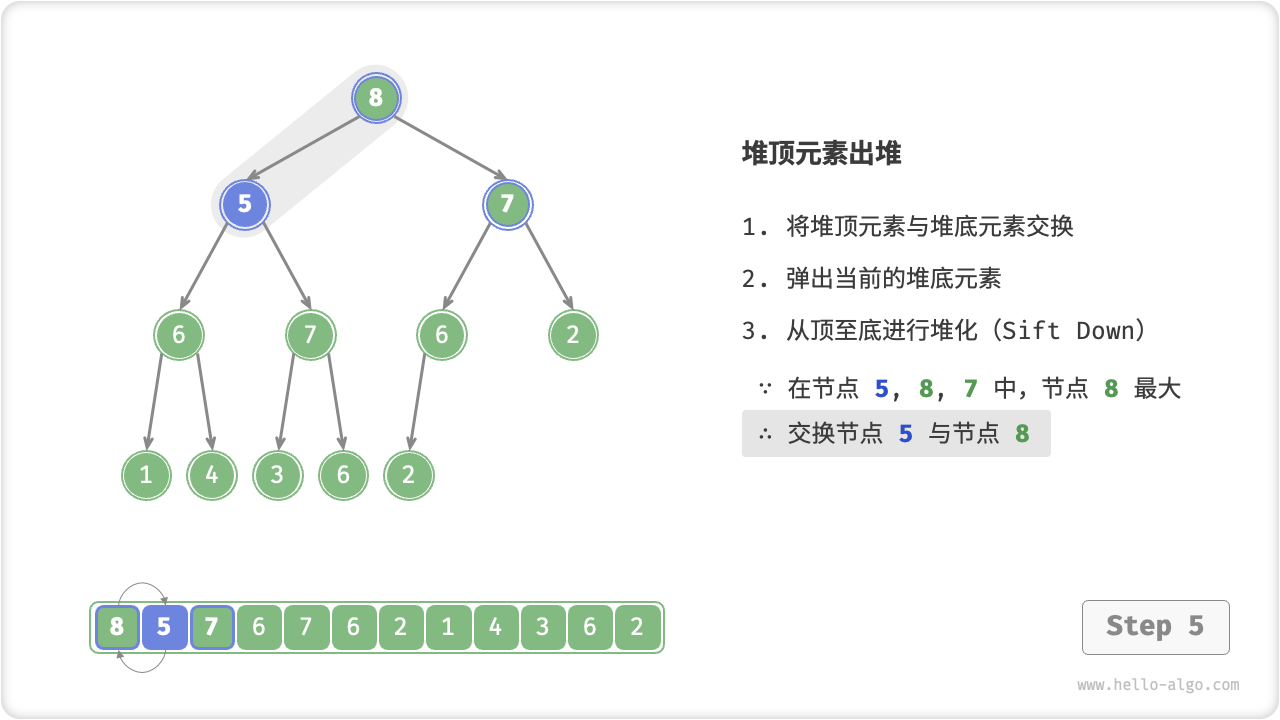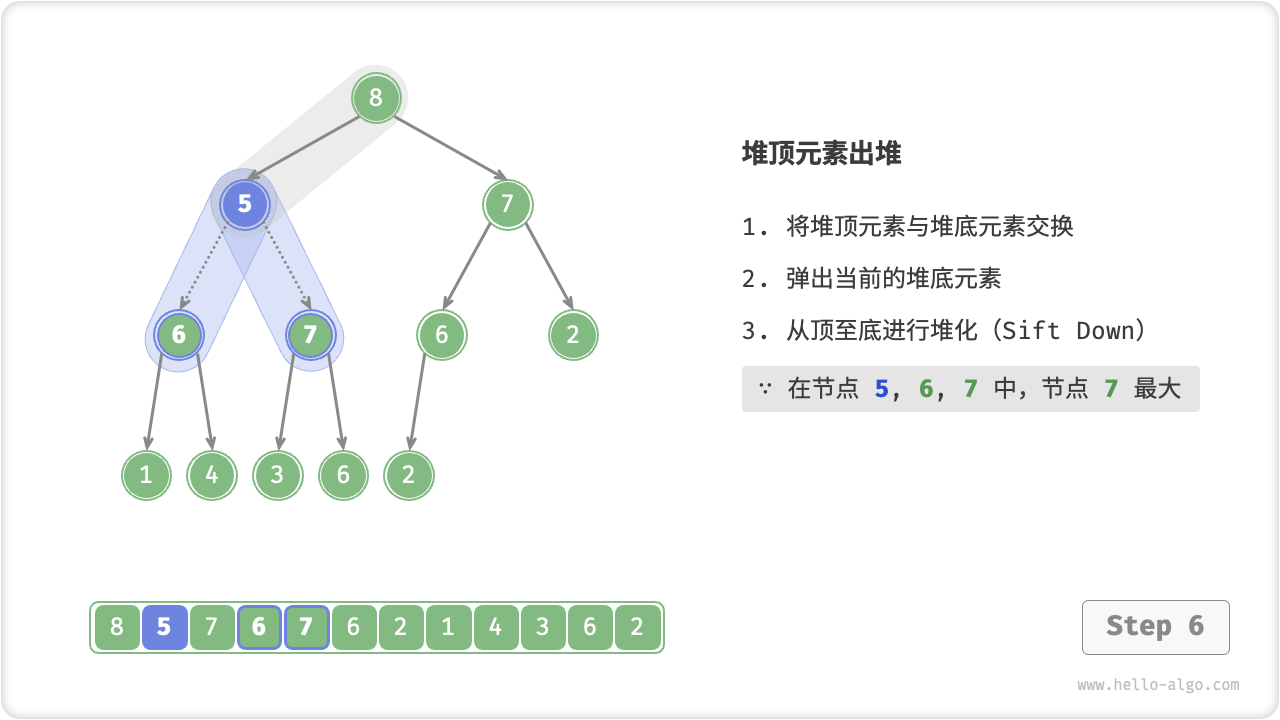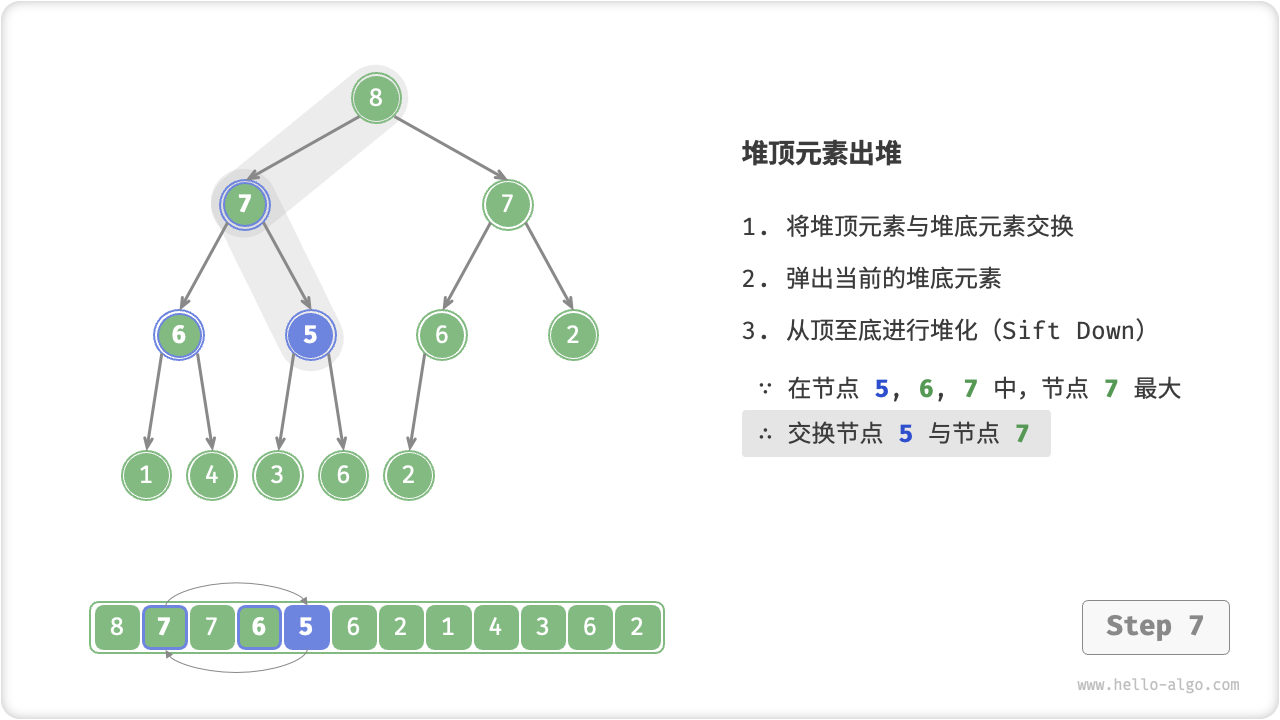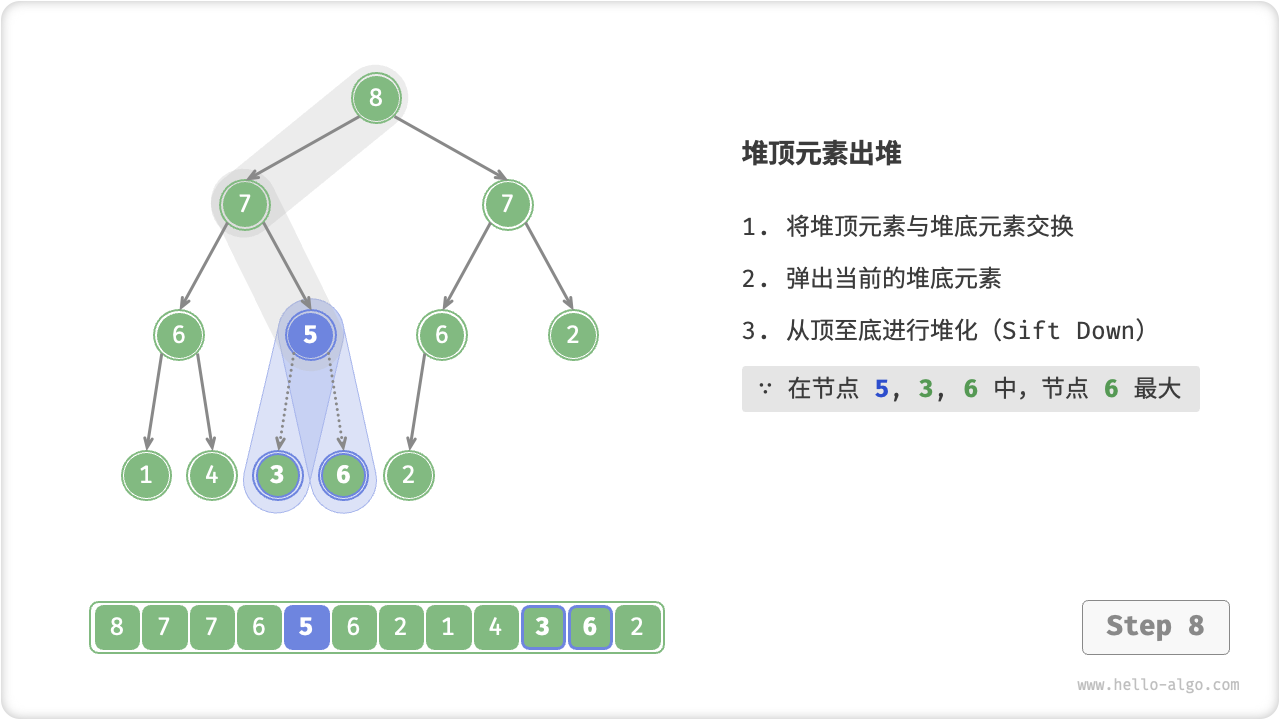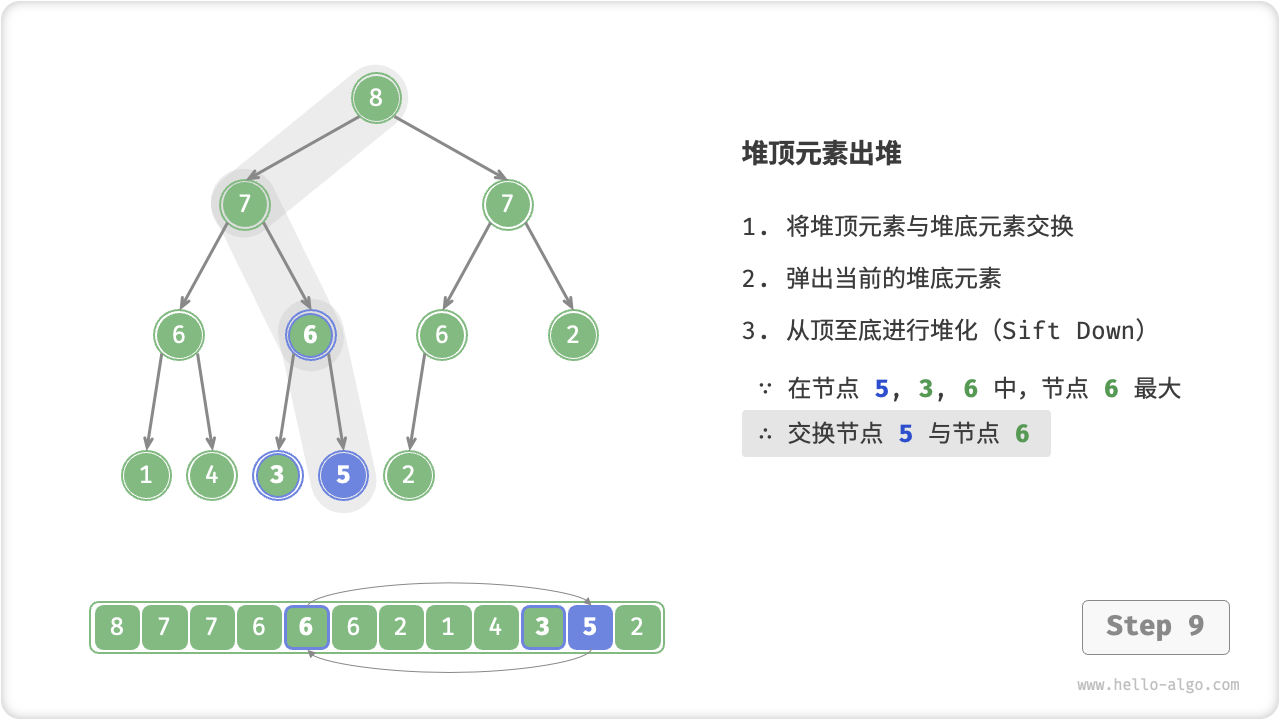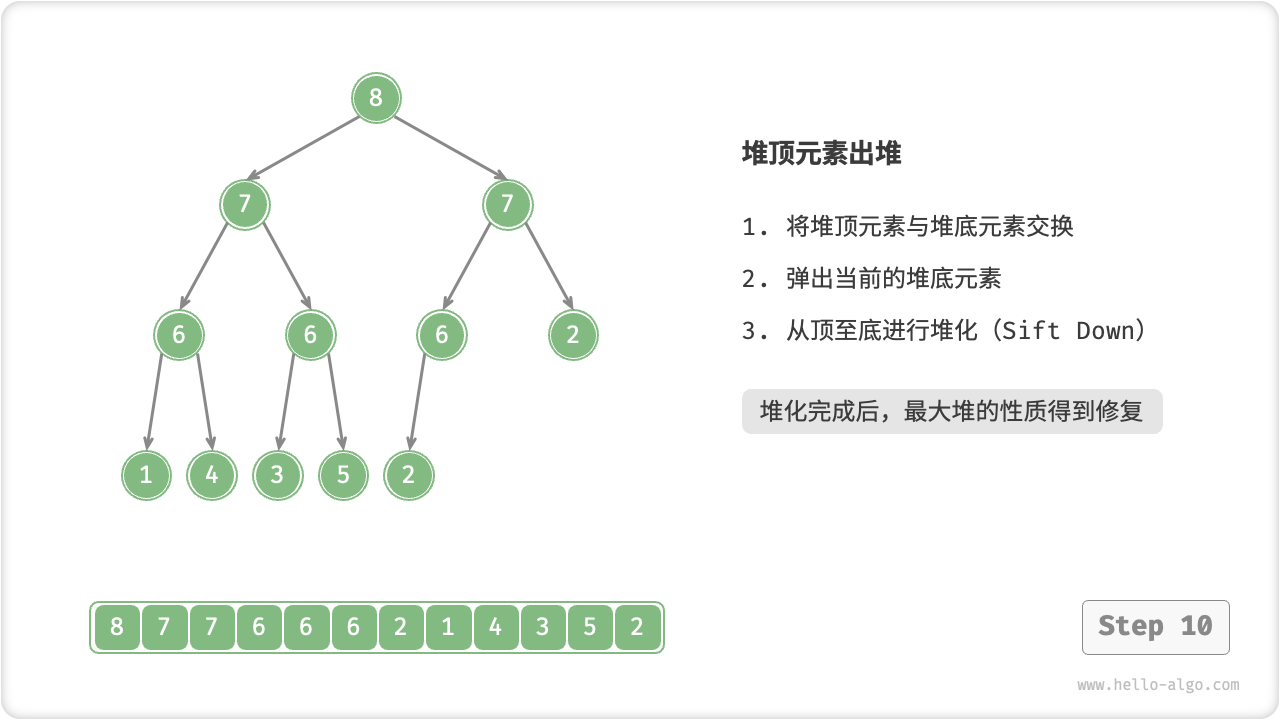20 KiB
堆
「堆 heap」是一种满足特定条件的完全二叉树,主要可分为下图所示的两种类型。
- 「大顶堆 max heap」:任意节点的值
\geq其子节点的值。 - 「小顶堆 min heap」:任意节点的值
\leq其子节点的值。
堆作为完全二叉树的一个特例,具有以下特性。
- 最底层节点靠左填充,其他层的节点都被填满。
- 我们将二叉树的根节点称为“堆顶”,将底层最靠右的节点称为“堆底”。
- 对于大顶堆(小顶堆),堆顶元素(即根节点)的值分别是最大(最小)的。
堆常用操作
需要指出的是,许多编程语言提供的是「优先队列 priority queue」,这是一种抽象数据结构,定义为具有优先级排序的队列。
实际上,堆通常用作实现优先队列,大顶堆相当于元素按从大到小顺序出队的优先队列。从使用角度来看,我们可以将“优先队列”和“堆”看作等价的数据结构。因此,本书对两者不做特别区分,统一使用“堆“来命名。
堆的常用操作见下表,方法名需要根据编程语言来确定。
表 堆的操作效率
| 方法名 | 描述 | 时间复杂度 |
|---|---|---|
| push() | 元素入堆 | O(\log n) |
| pop() | 堆顶元素出堆 | O(\log n) |
| peek() | 访问堆顶元素(大 / 小顶堆分别为最大 / 小值) | O(1) |
| size() | 获取堆的元素数量 | O(1) |
| isEmpty() | 判断堆是否为空 | O(1) |
在实际应用中,我们可以直接使用编程语言提供的堆类(或优先队列类)。
!!! tip
类似于排序算法中的“从小到大排列”和“从大到小排列”,我们可以通过修改 Comparator 来实现“小顶堆”与“大顶堆”之间的转换。
=== "Java"
```java title="heap.java"
/* 初始化堆 */
// 初始化小顶堆
Queue<Integer> minHeap = new PriorityQueue<>();
// 初始化大顶堆(使用 lambda 表达式修改 Comparator 即可)
Queue<Integer> maxHeap = new PriorityQueue<>((a, b) -> b - a);
/* 元素入堆 */
maxHeap.offer(1);
maxHeap.offer(3);
maxHeap.offer(2);
maxHeap.offer(5);
maxHeap.offer(4);
/* 获取堆顶元素 */
int peek = maxHeap.peek(); // 5
/* 堆顶元素出堆 */
// 出堆元素会形成一个从大到小的序列
peek = maxHeap.poll(); // 5
peek = maxHeap.poll(); // 4
peek = maxHeap.poll(); // 3
peek = maxHeap.poll(); // 2
peek = maxHeap.poll(); // 1
/* 获取堆大小 */
int size = maxHeap.size();
/* 判断堆是否为空 */
boolean isEmpty = maxHeap.isEmpty();
/* 输入列表并建堆 */
minHeap = new PriorityQueue<>(Arrays.asList(1, 3, 2, 5, 4));
```
=== "C++"
```cpp title="heap.cpp"
/* 初始化堆 */
// 初始化小顶堆
priority_queue<int, vector<int>, greater<int>> minHeap;
// 初始化大顶堆
priority_queue<int, vector<int>, less<int>> maxHeap;
/* 元素入堆 */
maxHeap.push(1);
maxHeap.push(3);
maxHeap.push(2);
maxHeap.push(5);
maxHeap.push(4);
/* 获取堆顶元素 */
int peek = maxHeap.top(); // 5
/* 堆顶元素出堆 */
// 出堆元素会形成一个从大到小的序列
maxHeap.pop(); // 5
maxHeap.pop(); // 4
maxHeap.pop(); // 3
maxHeap.pop(); // 2
maxHeap.pop(); // 1
/* 获取堆大小 */
int size = maxHeap.size();
/* 判断堆是否为空 */
bool isEmpty = maxHeap.empty();
/* 输入列表并建堆 */
vector<int> input{1, 3, 2, 5, 4};
priority_queue<int, vector<int>, greater<int>> minHeap(input.begin(), input.end());
```
=== "Python"
```python title="heap.py"
# 初始化小顶堆
min_heap, flag = [], 1
# 初始化大顶堆
max_heap, flag = [], -1
# Python 的 heapq 模块默认实现小顶堆
# 考虑将“元素取负”后再入堆,这样就可以将大小关系颠倒,从而实现大顶堆
# 在本示例中,flag = 1 时对应小顶堆,flag = -1 时对应大顶堆
# 元素入堆
heapq.heappush(max_heap, flag * 1)
heapq.heappush(max_heap, flag * 3)
heapq.heappush(max_heap, flag * 2)
heapq.heappush(max_heap, flag * 5)
heapq.heappush(max_heap, flag * 4)
# 获取堆顶元素
peek: int = flag * max_heap[0] # 5
# 堆顶元素出堆
# 出堆元素会形成一个从大到小的序列
val = flag * heapq.heappop(max_heap) # 5
val = flag * heapq.heappop(max_heap) # 4
val = flag * heapq.heappop(max_heap) # 3
val = flag * heapq.heappop(max_heap) # 2
val = flag * heapq.heappop(max_heap) # 1
# 获取堆大小
size: int = len(max_heap)
# 判断堆是否为空
is_empty: bool = not max_heap
# 输入列表并建堆
min_heap: list[int] = [1, 3, 2, 5, 4]
heapq.heapify(min_heap)
```
=== "Go"
```go title="heap.go"
// Go 语言中可以通过实现 heap.Interface 来构建整数大顶堆
// 实现 heap.Interface 需要同时实现 sort.Interface
type intHeap []any
// Push heap.Interface 的方法,实现推入元素到堆
func (h *intHeap) Push(x any) {
// Push 和 Pop 使用 pointer receiver 作为参数
// 因为它们不仅会对切片的内容进行调整,还会修改切片的长度。
*h = append(*h, x.(int))
}
// Pop heap.Interface 的方法,实现弹出堆顶元素
func (h *intHeap) Pop() any {
// 待出堆元素存放在最后
last := (*h)[len(*h)-1]
*h = (*h)[:len(*h)-1]
return last
}
// Len sort.Interface 的方法
func (h *intHeap) Len() int {
return len(*h)
}
// Less sort.Interface 的方法
func (h *intHeap) Less(i, j int) bool {
// 如果实现小顶堆,则需要调整为小于号
return (*h)[i].(int) > (*h)[j].(int)
}
// Swap sort.Interface 的方法
func (h *intHeap) Swap(i, j int) {
(*h)[i], (*h)[j] = (*h)[j], (*h)[i]
}
// Top 获取堆顶元素
func (h *intHeap) Top() any {
return (*h)[0]
}
/* Driver Code */
func TestHeap(t *testing.T) {
/* 初始化堆 */
// 初始化大顶堆
maxHeap := &intHeap{}
heap.Init(maxHeap)
/* 元素入堆 */
// 调用 heap.Interface 的方法,来添加元素
heap.Push(maxHeap, 1)
heap.Push(maxHeap, 3)
heap.Push(maxHeap, 2)
heap.Push(maxHeap, 4)
heap.Push(maxHeap, 5)
/* 获取堆顶元素 */
top := maxHeap.Top()
fmt.Printf("堆顶元素为 %d\n", top)
/* 堆顶元素出堆 */
// 调用 heap.Interface 的方法,来移除元素
heap.Pop(maxHeap) // 5
heap.Pop(maxHeap) // 4
heap.Pop(maxHeap) // 3
heap.Pop(maxHeap) // 2
heap.Pop(maxHeap) // 1
/* 获取堆大小 */
size := len(*maxHeap)
fmt.Printf("堆元素数量为 %d\n", size)
/* 判断堆是否为空 */
isEmpty := len(*maxHeap) == 0
fmt.Printf("堆是否为空 %t\n", isEmpty)
}
```
=== "JS"
```javascript title="heap.js"
// JavaScript 未提供内置 Heap 类
```
=== "TS"
```typescript title="heap.ts"
// TypeScript 未提供内置 Heap 类
```
=== "C"
```c title="heap.c"
// C 未提供内置 Heap 类
```
=== "C#"
```csharp title="heap.cs"
/* 初始化堆 */
// 初始化小顶堆
PriorityQueue<int, int> minHeap = new PriorityQueue<int, int>();
// 初始化大顶堆(使用 lambda 表达式修改 Comparator 即可)
PriorityQueue<int, int> maxHeap = new PriorityQueue<int, int>(Comparer<int>.Create((x, y) => y - x));
/* 元素入堆 */
maxHeap.Enqueue(1, 1);
maxHeap.Enqueue(3, 3);
maxHeap.Enqueue(2, 2);
maxHeap.Enqueue(5, 5);
maxHeap.Enqueue(4, 4);
/* 获取堆顶元素 */
int peek = maxHeap.Peek();//5
/* 堆顶元素出堆 */
// 出堆元素会形成一个从大到小的序列
peek = maxHeap.Dequeue(); // 5
peek = maxHeap.Dequeue(); // 4
peek = maxHeap.Dequeue(); // 3
peek = maxHeap.Dequeue(); // 2
peek = maxHeap.Dequeue(); // 1
/* 获取堆大小 */
int size = maxHeap.Count;
/* 判断堆是否为空 */
bool isEmpty = maxHeap.Count == 0;
/* 输入列表并建堆 */
minHeap = new PriorityQueue<int, int>(new List<(int, int)> { (1, 1), (3, 3), (2, 2), (5, 5), (4, 4), });
```
=== "Swift"
```swift title="heap.swift"
// Swift 未提供内置 Heap 类
```
=== "Zig"
```zig title="heap.zig"
```
=== "Dart"
```dart title="heap.dart"
// Dart 未提供内置 Heap 类
```
=== "Rust"
```rust title="heap.rs"
```
堆的实现
下文实现的是大顶堆。若要将其转换为小顶堆,只需将所有大小逻辑判断取逆(例如,将 \geq 替换为 \leq )。感兴趣的读者可以自行实现。
堆的存储与表示
我们在二叉树章节中学习到,完全二叉树非常适合用数组来表示。由于堆正是一种完全二叉树,我们将采用数组来存储堆。
当使用数组表示二叉树时,元素代表节点值,索引代表节点在二叉树中的位置。节点指针通过索引映射公式来实现。
如下图所示,给定索引 i ,其左子节点索引为 2i + 1 ,右子节点索引为 2i + 2 ,父节点索引为 (i - 1) / 2(向下取整)。当索引越界时,表示空节点或节点不存在。
我们可以将索引映射公式封装成函数,方便后续使用。
=== "Java"
```java title="my_heap.java"
[class]{MaxHeap}-[func]{left}
[class]{MaxHeap}-[func]{right}
[class]{MaxHeap}-[func]{parent}
```
=== "C++"
```cpp title="my_heap.cpp"
[class]{MaxHeap}-[func]{left}
[class]{MaxHeap}-[func]{right}
[class]{MaxHeap}-[func]{parent}
```
=== "Python"
```python title="my_heap.py"
[class]{MaxHeap}-[func]{left}
[class]{MaxHeap}-[func]{right}
[class]{MaxHeap}-[func]{parent}
```
=== "Go"
```go title="my_heap.go"
[class]{maxHeap}-[func]{left}
[class]{maxHeap}-[func]{right}
[class]{maxHeap}-[func]{parent}
```
=== "JS"
```javascript title="my_heap.js"
[class]{MaxHeap}-[func]{#left}
[class]{MaxHeap}-[func]{#right}
[class]{MaxHeap}-[func]{#parent}
```
=== "TS"
```typescript title="my_heap.ts"
[class]{MaxHeap}-[func]{left}
[class]{MaxHeap}-[func]{right}
[class]{MaxHeap}-[func]{parent}
```
=== "C"
```c title="my_heap.c"
[class]{maxHeap}-[func]{left}
[class]{maxHeap}-[func]{right}
[class]{maxHeap}-[func]{parent}
```
=== "C#"
```csharp title="my_heap.cs"
[class]{MaxHeap}-[func]{left}
[class]{MaxHeap}-[func]{right}
[class]{MaxHeap}-[func]{parent}
```
=== "Swift"
```swift title="my_heap.swift"
[class]{MaxHeap}-[func]{left}
[class]{MaxHeap}-[func]{right}
[class]{MaxHeap}-[func]{parent}
```
=== "Zig"
```zig title="my_heap.zig"
[class]{MaxHeap}-[func]{left}
[class]{MaxHeap}-[func]{right}
[class]{MaxHeap}-[func]{parent}
```
=== "Dart"
```dart title="my_heap.dart"
[class]{MaxHeap}-[func]{_left}
[class]{MaxHeap}-[func]{_right}
[class]{MaxHeap}-[func]{_parent}
```
=== "Rust"
```rust title="my_heap.rs"
[class]{MaxHeap}-[func]{left}
[class]{MaxHeap}-[func]{right}
[class]{MaxHeap}-[func]{parent}
```
访问堆顶元素
堆顶元素即为二叉树的根节点,也就是列表的首个元素。
=== "Java"
```java title="my_heap.java"
[class]{MaxHeap}-[func]{peek}
```
=== "C++"
```cpp title="my_heap.cpp"
[class]{MaxHeap}-[func]{peek}
```
=== "Python"
```python title="my_heap.py"
[class]{MaxHeap}-[func]{peek}
```
=== "Go"
```go title="my_heap.go"
[class]{maxHeap}-[func]{peek}
```
=== "JS"
```javascript title="my_heap.js"
[class]{MaxHeap}-[func]{peek}
```
=== "TS"
```typescript title="my_heap.ts"
[class]{MaxHeap}-[func]{peek}
```
=== "C"
```c title="my_heap.c"
[class]{maxHeap}-[func]{peek}
```
=== "C#"
```csharp title="my_heap.cs"
[class]{MaxHeap}-[func]{peek}
```
=== "Swift"
```swift title="my_heap.swift"
[class]{MaxHeap}-[func]{peek}
```
=== "Zig"
```zig title="my_heap.zig"
[class]{MaxHeap}-[func]{peek}
```
=== "Dart"
```dart title="my_heap.dart"
[class]{MaxHeap}-[func]{peek}
```
=== "Rust"
```rust title="my_heap.rs"
[class]{MaxHeap}-[func]{peek}
```
元素入堆
给定元素 val ,我们首先将其添加到堆底。添加之后,由于 val 可能大于堆中其他元素,堆的成立条件可能已被破坏。因此,需要修复从插入节点到根节点的路径上的各个节点,这个操作被称为「堆化 heapify」。
考虑从入堆节点开始,从底至顶执行堆化。如下图所示,我们比较插入节点与其父节点的值,如果插入节点更大,则将它们交换。然后继续执行此操作,从底至顶修复堆中的各个节点,直至越过根节点或遇到无须交换的节点时结束。
设节点总数为 n ,则树的高度为 O(\log n) 。由此可知,堆化操作的循环轮数最多为 O(\log n) ,元素入堆操作的时间复杂度为 O(\log n) 。
=== "Java"
```java title="my_heap.java"
[class]{MaxHeap}-[func]{push}
[class]{MaxHeap}-[func]{siftUp}
```
=== "C++"
```cpp title="my_heap.cpp"
[class]{MaxHeap}-[func]{push}
[class]{MaxHeap}-[func]{siftUp}
```
=== "Python"
```python title="my_heap.py"
[class]{MaxHeap}-[func]{push}
[class]{MaxHeap}-[func]{sift_up}
```
=== "Go"
```go title="my_heap.go"
[class]{maxHeap}-[func]{push}
[class]{maxHeap}-[func]{siftUp}
```
=== "JS"
```javascript title="my_heap.js"
[class]{MaxHeap}-[func]{push}
[class]{MaxHeap}-[func]{#siftUp}
```
=== "TS"
```typescript title="my_heap.ts"
[class]{MaxHeap}-[func]{push}
[class]{MaxHeap}-[func]{siftUp}
```
=== "C"
```c title="my_heap.c"
[class]{maxHeap}-[func]{push}
[class]{maxHeap}-[func]{siftUp}
```
=== "C#"
```csharp title="my_heap.cs"
[class]{MaxHeap}-[func]{push}
[class]{MaxHeap}-[func]{siftUp}
```
=== "Swift"
```swift title="my_heap.swift"
[class]{MaxHeap}-[func]{push}
[class]{MaxHeap}-[func]{siftUp}
```
=== "Zig"
```zig title="my_heap.zig"
[class]{MaxHeap}-[func]{push}
[class]{MaxHeap}-[func]{siftUp}
```
=== "Dart"
```dart title="my_heap.dart"
[class]{MaxHeap}-[func]{push}
[class]{MaxHeap}-[func]{siftUp}
```
=== "Rust"
```rust title="my_heap.rs"
[class]{MaxHeap}-[func]{push}
[class]{MaxHeap}-[func]{sift_up}
```
堆顶元素出堆
堆顶元素是二叉树的根节点,即列表首元素。如果我们直接从列表中删除首元素,那么二叉树中所有节点的索引都会发生变化,这将使得后续使用堆化修复变得困难。为了尽量减少元素索引的变动,我们采用以下操作步骤。
- 交换堆顶元素与堆底元素(即交换根节点与最右叶节点)。
- 交换完成后,将堆底从列表中删除(注意,由于已经交换,实际上删除的是原来的堆顶元素)。
- 从根节点开始,从顶至底执行堆化。
如下图所示,“从顶至底堆化”的操作方向与“从底至顶堆化”相反,我们将根节点的值与其两个子节点的值进行比较,将最大的子节点与根节点交换。然后循环执行此操作,直到越过叶节点或遇到无须交换的节点时结束。
与元素入堆操作相似,堆顶元素出堆操作的时间复杂度也为 O(\log n) 。
=== "Java"
```java title="my_heap.java"
[class]{MaxHeap}-[func]{pop}
[class]{MaxHeap}-[func]{siftDown}
```
=== "C++"
```cpp title="my_heap.cpp"
[class]{MaxHeap}-[func]{pop}
[class]{MaxHeap}-[func]{siftDown}
```
=== "Python"
```python title="my_heap.py"
[class]{MaxHeap}-[func]{pop}
[class]{MaxHeap}-[func]{sift_down}
```
=== "Go"
```go title="my_heap.go"
[class]{maxHeap}-[func]{pop}
[class]{maxHeap}-[func]{siftDown}
```
=== "JS"
```javascript title="my_heap.js"
[class]{MaxHeap}-[func]{pop}
[class]{MaxHeap}-[func]{#siftDown}
```
=== "TS"
```typescript title="my_heap.ts"
[class]{MaxHeap}-[func]{pop}
[class]{MaxHeap}-[func]{siftDown}
```
=== "C"
```c title="my_heap.c"
[class]{maxHeap}-[func]{pop}
[class]{maxHeap}-[func]{siftDown}
```
=== "C#"
```csharp title="my_heap.cs"
[class]{MaxHeap}-[func]{pop}
[class]{MaxHeap}-[func]{siftDown}
```
=== "Swift"
```swift title="my_heap.swift"
[class]{MaxHeap}-[func]{pop}
[class]{MaxHeap}-[func]{siftDown}
```
=== "Zig"
```zig title="my_heap.zig"
[class]{MaxHeap}-[func]{pop}
[class]{MaxHeap}-[func]{siftDown}
```
=== "Dart"
```dart title="my_heap.dart"
[class]{MaxHeap}-[func]{pop}
[class]{MaxHeap}-[func]{siftDown}
```
=== "Rust"
```rust title="my_heap.rs"
[class]{MaxHeap}-[func]{pop}
[class]{MaxHeap}-[func]{sift_down}
```
堆常见应用
- 优先队列:堆通常作为实现优先队列的首选数据结构,其入队和出队操作的时间复杂度均为
O(\log n),而建队操作为O(n),这些操作都非常高效。 - 堆排序:给定一组数据,我们可以用它们建立一个堆,然后不断地执行元素出堆操作,从而得到有序数据。然而,我们通常会使用一种更优雅的方式实现堆排序,详见后续的堆排序章节。
- 获取最大的
k个元素:这是一个经典的算法问题,同时也是一种典型应用,例如选择热度前 10 的新闻作为微博热搜,选取销量前 10 的商品等。
